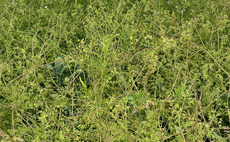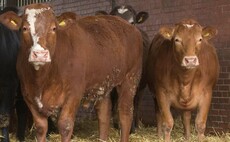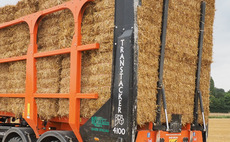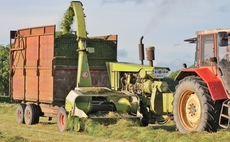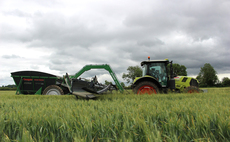Any grower with a ryegrass weed population on-farm should treat it as a big problem, warns one leading agronomist. Arable Farming reports.
Italian ryegrass and black-grass have many similarities, but there are some important differences on what control strategies work best. Spring-applied post-ems are a case in point; research shows that susceptibility to ALS-chemistry is much more common in ryegrass than black-grass.
John Cussans, weed biology and management specialist at NIAB, who led the 2021 NIAB/Bayer ryegrass survey, says: When it comes to Italian ryegrass management, we cant rely on the black-grass template.
Cultural control approaches that have served us so well in black-grass management are acting differently in Italian ryegrass. The same is true of herbicides. Think about the weed sensitivity of the populations you have in the field and tailor your programme accordingly.
The 2021 survey resistance tested 197 populations, finding nearly half still susceptible to Atlantis-type chemistry (HRAC Group 2), while pinoxaden (HRAC Group 1) was still effective against many populations as well.
Table: Italian ryegrass susceptibility to post-em chemistry
Source: NIAB/Bayer CropScience
If you surveyed people and asked how many think ALS doesnt work on Italian ryegrass, I expect it would be a much higher number than what we found in the survey, says Mr Cussans.
Its not because those people arent having problems controlling Italian ryegrass, but the source of the problem is perhaps not what they imagine it is.
This view is shared by Bayers Tom Chillcott who has seen a similar situation in Bayers own resistance testing programme.
He says: In 2021 and 2022 we tested 17 ryegrass samples submitted by farmers or agronomists for herbicide resistance. Ten of these came back as susceptible to ALS-chemistry, he says.
This spring, farmers can use the latest version of this chemistry, Atlantis Star, which includes thiencarbazone alongside mesosulfuron and iodosulfuron. The addition of thiencarbazone improves grass-weed control, including ryegrass, by 5-10%.
Resistance status only part of the problem
Tests in the field are one thing but seeing the difference in the field is another. Agronomist Andrew Blazey of Prime Agriculture and chairman of the Association of Independent Crop Consultants submitted two samples to the ryegrass survey from farms in the East Anglia. In both cases, the farmers wanted to know more about the ryegrass problem which needed ever more attention to keep it under control.
He says: I dont think you can ever get completely in control of ryegrass, but you can keep it manageable. On the two farms, we noticed ryegrass was popping up in more places from the usual problem fields, so it was important to have a better understanding of it.
On one farm, the resistance tests came back broadly as expected: RR to ALS and pinoxaden and reduced control from pre-ems too. About four years ago we had already realised the extent of the ryegrass problem and the farmer is fully on board with managing resistance. He sows a reduced area of second wheats and aggressively controls patches with glyphosate and carries a knapsack sprayer in the cab during T2 and T3 applications to spray off any individual plants or small patches.
In hindsight, we shouldve done the resistance testing three or four years ago to be sure about what we were dealing with because it is not always predictable, as the sample from the other farm showed. The second result surprised me, it came back as susceptible to ALS and pinoxaden, even though we used Pacifica (mesosulfuron + iodosulfuron) and Broadway Star (pyroxsulam + fluroyxpyr) fairly extensively on-farm.
Given my experience on the farm, Im not sure the result that came back is reflective of the situation in every field, so we are looking at doing some strip trials this spring to test ALS-performance.
Looking at the results from the whole survey, Mr Blazey thinks there is a lesson in this to look at application technique.
Its not the case that a susceptible resistance test means you can apply a post-em whenever and however and expect to get control. John Cussans and the team at NIAB apply products in a glasshouse, to a dry leaf, ensuring consistent coverage and so on. Conditions for a field application will never be as good, but there are ways we can increase the chances of a good result.
�������� looking to hit grass-weeds when they are small in February ought to think of it as a one-tank-a-day operation. Realistically, there is a two-hour window from midday to 2pm to spray with sufficient drying time before dusk and dew formation.
He points out that it is essential to have active growth and a lack of rain or strong wind, so getting a good result with a post-em requires patience and a clear idea which fields will benefit from an application to prioritise sprays.
For farmers with any sort of ryegrass problem, Mr Blazey insists they get the fundamentals right before they start thinking about herbicides which are the cherry on top.
Anyone with ryegrass should treat it as a big problem, regardless of the resistance status. Hygiene and husbandry are key to managing the problem in the long-term. Ryegrass seed tends to hang on to the combine for longer, blow down the combine between each field and clean cultivation equipment too.
Cultural control techniques are familiar to everyone from black-grass, the general rule is they all work for ryegrass, but not quite as well, so you need more of them and really good attention to detail.
In the field: Ben Binder, Kent
Italian ryegrass has been a problem for farm manager Ben Binder in nearly two decades at the Belmont Estate, Kent.
He says: We never stopped using Atlantis entirely and resistance test results show it was the right decision, but we still need the pre-ems to perform. From the walking Ive done in December and January, pre-em control hasnt been as good this year, so we need to get as much as possible from the post-ems this spring.
Trials and resistance testing on-farm have shown several spring post-ems should still have something to offer against ryegrass. But on a field scale, we have had the best results from Atlantis-type products, the other options dont give enough control.
Mr Binder has used Proverb (mesosulfuron + iodosulfuron + thiencarbazone) which is the same formulation as Atlantis Star and which has been available on a limited distribution for two seasons. Overall, he assesses the control as reasonable, but a lot depends on application conditions, he says.
There are so many factors involved in Atlantis performance that you can easily get a poor result if youre not careful. My observations are that light intensity is key, applying on a clear day with bright sunshine usually gives better results than on a dull day, irrespective of the date. Obviously, you cant apply in freezing weather and spray from mid-morning to mid-afternoon to get the drying time.






